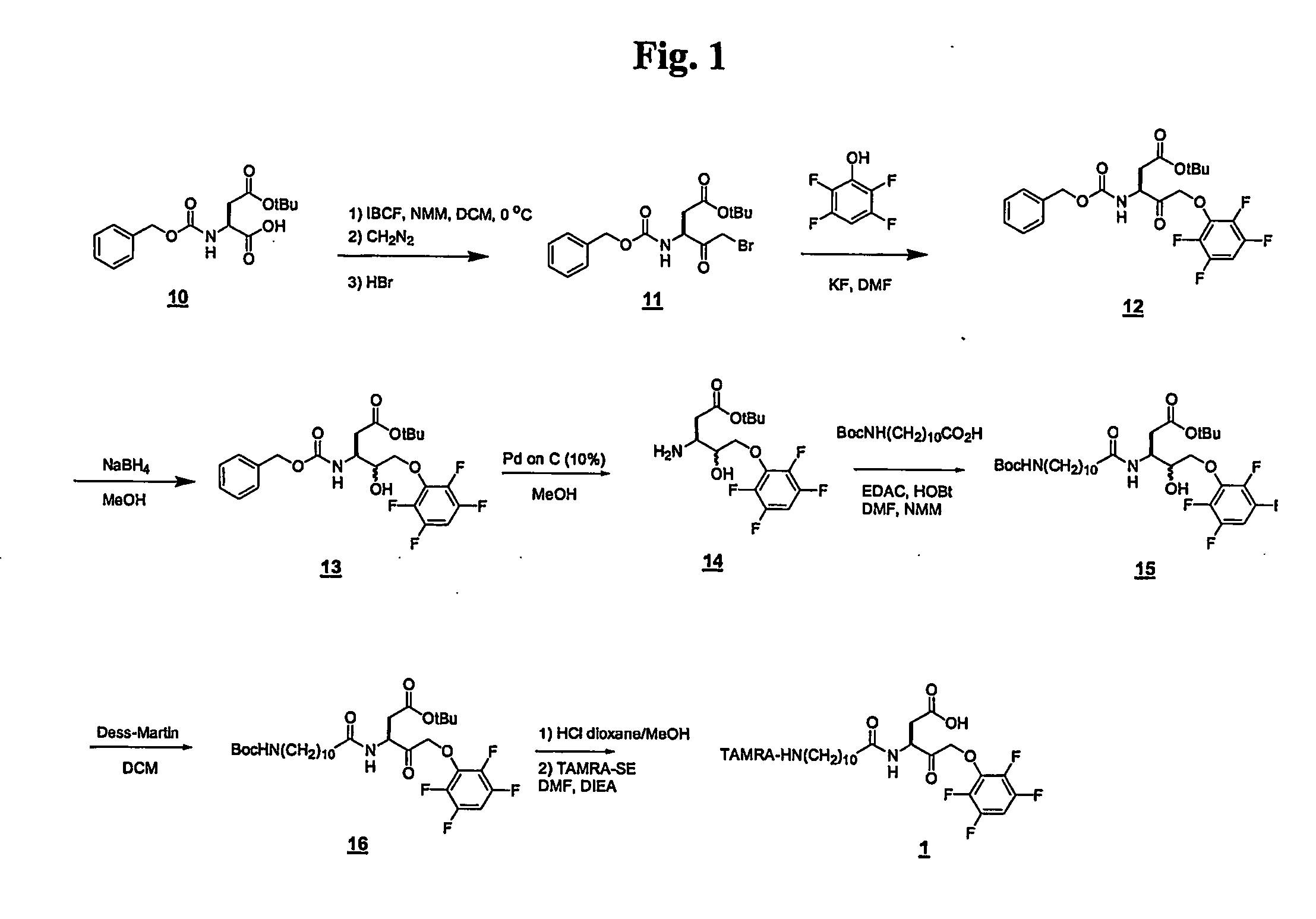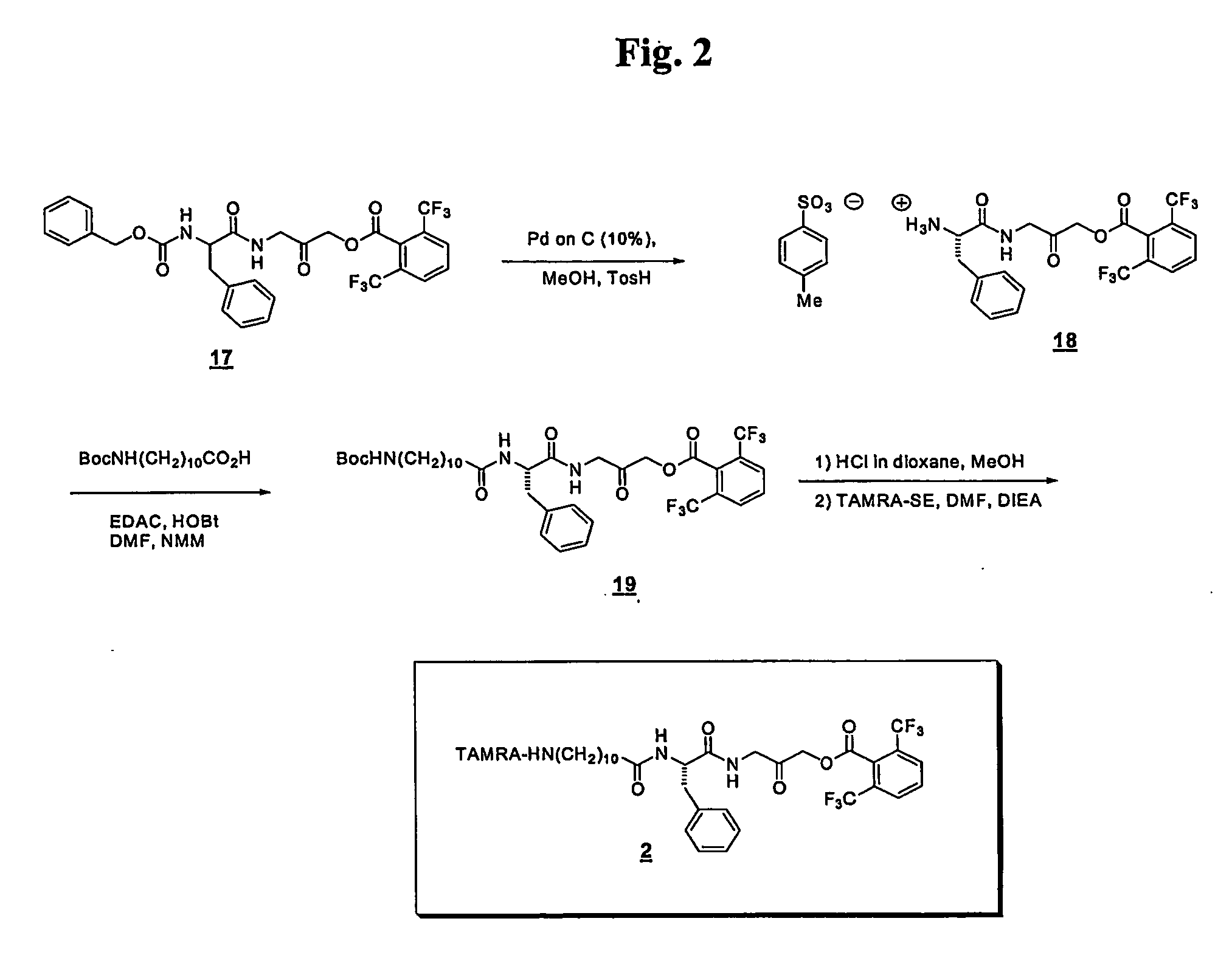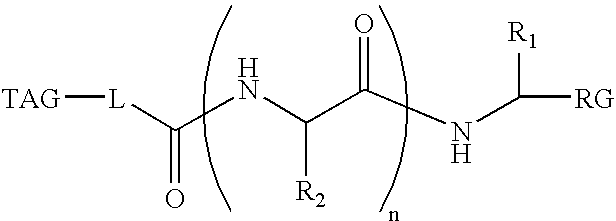Activity-based probes and methods of their preparation ans use
a technology of activity-based probes and probes, which is applied in the field of affinity labeling of catalytically active enzymes, can solve the problems of severe host problems, and achieve the effect of increasing the catalytic activity of target enzymes
- Summary
- Abstract
- Description
- Claims
- Application Information
AI Technical Summary
Benefits of technology
Problems solved by technology
Method used
Image
Examples
example 1
Manufacture of Caspase-Related Probes
[0077] The following examples illustrate some embodiments of methods for manufacturing the ABPs of the present invention. In each of these embodiments, 1H-NMR spectra were recorded using deuterated chloroform (CDCl3; δ=7.26 ppm) as the solvent (unless otherwise indicated). Preparative HPLC was carried out on a reverse phase Polaris C18 column (5 μm column; 150 mm×21 mm; Metachem / Ansys; Torrance, Calif.) using a binary system of water and acetonitrile with trifluoroacetate as a modifier (water 0.1%, acetonitrile 0.08%). Analytical LC-MS was carried out on a Polaris C18 column (5μ column; 50 mm×4.6 mm; Metachem / Ansys; Torrance, Calif.) using a binary system of water and acetonitrile with TFA as a modifier (water 0.025%, acetonitrile 0.02%). The detectable TAGs were the mixed succinimidyl esters of 5-(and 6)-carboxytetramethylrhodamine (TAMRA-SE; Molecular Probes; Eugene, Oreg.), Boc-11-aminoundecanoic acid, and Cbz-Asp(OtBut)-OH (Calbiochem-Novach...
example 2
Manufacture of Cathepsin-Related Probes
2,6-Bis-trifluoromethyl-benzoicacid-3-(2-amino-3-phenyl-propionylamino)-2-oxo-propyl ester (18)
[0086] Composition 17 (150 mg, 0.25 mmol), p-toluenesulfonic acid monohydrate (76 mg, 0.40 mmol, 2 equiv) and MeOH (15 mL) were added to a dry round bottom flask equipped with a magnetic stir bar. The flask was purged several times with N2 and a catalytic amount of 10% Pd on C was added to the reaction. The resulting black heterogeneous mixture was evacuated and charged twice with H2 via a rubber balloon with constant stirring. The reaction was stirred at room temperature for 1.5 h. Upon completion the mixture was filtered through a pad of Celite and concentrated in vacuo to give 18 (94 mg, 0.24 mmol, 99% yield) as a sticky off-white solid. ESMS: 477.8 (M+H+), 499.1 (M+Na+).
2,6-Bis-trifluoromethyl-benzoic acid 3-[2-(11-tert-butoxycarbonylamino-10-methyl-undecanoylamino)-3-phenyl-propionylamino]-2-oxo-propyl ester (19)
[0087] Boc-11-amino-undecanoic...
PUM
| Property | Measurement | Unit |
|---|---|---|
| Structure | aaaaa | aaaaa |
Abstract
Description
Claims
Application Information
 Login to View More
Login to View More - R&D
- Intellectual Property
- Life Sciences
- Materials
- Tech Scout
- Unparalleled Data Quality
- Higher Quality Content
- 60% Fewer Hallucinations
Browse by: Latest US Patents, China's latest patents, Technical Efficacy Thesaurus, Application Domain, Technology Topic, Popular Technical Reports.
© 2025 PatSnap. All rights reserved.Legal|Privacy policy|Modern Slavery Act Transparency Statement|Sitemap|About US| Contact US: help@patsnap.com



